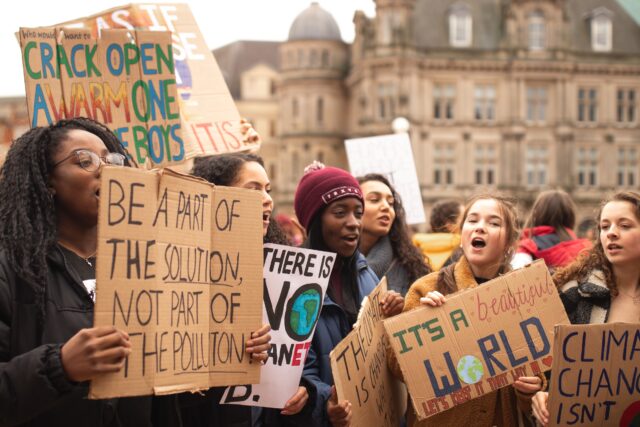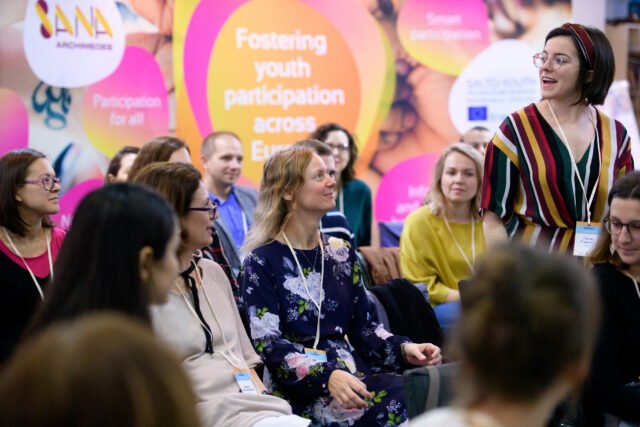Story of an environmental awakening
Year of production: 2021
How young people opened our eyes to the climate crisis, and helped environmental sustainability become a priority in EU youth programmes
I started working with European youth programmes 10 years ago. At the time, a search for the words “environment” or “sustainability” in the Programme Guide of what was back then the Youth in Action programme (now Erasmus+), would retrieve zero results. It was very difficult for me as an applicant to make my environmental education projects eligible for funding. Today, I can be very straightforward with the aims and objectives of the projects that I create, because environmental sustainability is finally a priority. But how did this come to be?

How young people brought awareness to the climate crisis
Environmental awareness is not something new. It started soon after the industrial revolution, when pollution coming from industrial processes started to become a problem. Not much was done to mitigate the impacts, and over time, the problems grew bigger and wider: nuclear accidents, oil spills, melting glaciers, rising sea levels, extreme weather events, the 6th mass extinction… And still, only 5 years ago, the public and media focus on environmental issues was minimal.
20 August 2018: a 15-year-old girl with Asperger’s syndrome sits in front of the Swedish parliament holding a handmade sign reading “Skolstrejk för klimatet” (“School strike for climate”). She says she wants her government to reduce their carbon emissions according to the compromises established in the Paris Agreement. She’s going to sit there until somebody listens to her, because she’s heard enough empty promises, and because she’s young and she’s angry, and why not.
5 months later, more than 20,000 students strike for the climate in more than 270 cities in several countries. Greta Thunberg has clearly played a crucial role in increasing environmental awareness in recent years. But also all of her followers who organised the Fridays for Future movement, and many other leading youngsters in different parts of the world, such as Rebeca Hamilton, founder of Sustainabiliteens, a group of young environmental activists who organised the largest climate crisis protest in the history of Vancouver. Or Young Friends of the Earth Europe, who have been coordinating the participation of young people in climate negotiations, and in some of the biggest climate marches in history, such as the one in Copenhagen back in 2009. That was massive. And I know it was, because I was there.
Young activists have massively helped to bring the climate crisis to the media. Those mass strikes all over the planet simply couldn’t be ignored. But media attention is not all we need in order to make a change.
Young people shaping youth policies and programmes

In parallel, other groups of young people were working on a different course of action. Over 50,000 young people from around Europe participated in the Youth Dialogue process. This process is structured in 18-month work cycles, each one of them focusing on a different thematic priority set by the Council of Youth Ministers. During each cycle, the national working group of every EU country conducts a national consultation of young people and youth organisations on the corresponding priority. These national working groups are composed of representatives of youth ministries, national youth councils, youth organisations, youth workers, researchers and young people from all backgrounds. In this way, young people get to have their say on the priorities, implementation and follow-up of European youth policies and programmes.
One of the outcomes of the EU Youth Dialogue was the formulation of 11 Youth Goals, which have then been included in the EU Youth Strategy and have been taken into account in the development of EU youth programmes and policies. Goal number 10 is a “Sustainable and Green Europe”: “to achieve a society in which all young people are environmentally active, educated and able to make a difference in their everyday lives.” Goal number 9 is “Space and Participation for All”: “to strengthen young people’s democratic participation and autonomy as well as provide dedicated youth spaces in all areas of society.” It seems quite evident that young people want to see a green transition, and that they want to be involved in the decision-making processes that will make this happen.
Youth workers are aware of these needs, and have therefore taken them into account in the Final Declaration of the 3rd European Youth Work Convention. This document can be described as a set of guidelines for European youth work. We co-created it in December last year (2020) during a 3 day online event attended by hundreds of youth workers across Europe. These guidelines include the following priority:
“Making youth work greener. Encourage and prioritise practices and solutions that are environmentally friendly, aligned with the principles of sustainable development that youth work seeks to instil and young people expect.” [3rd European Youth Work Convention].
In spring this year, the Erasmus+ Programme Guide was released. This is “the Bible” for every youth worker involved in the organisation of European mobility programmes, Solidarity Corps volunteering projects, etc. It determines the conditions under which European Youth Programmes should be organised for being eligible for funding, and sets the priorities of the programme for its validity period. The current programme runs from 2021 to 2027 and the guide talks about “contributing to greener societies” from paragraph one.
Considering all I have mentioned so far in this article, I think it’s pretty clear that it is not a coincidence that one of the horizontal priorities fundamentally important for designing a youth project, is “environmental sustainability”. This is how it is described in the Programme Guide:
“Projects should be designed in an eco-friendly way and should incorporate green practices in all their facets. Organisations and participants should have an environmentally-friendly approach when designing the project, which will encourage everyone involved in the project to discuss and learn about environmental issues, reflecting on what can be done at different levels and helping organisations and participants to come up with alternative, greener ways of implementing project activities.” [Erasmus+ Programme Guide].
It’s a fantastic leap ahead, and a very big change from the scene I encountered 10 years ago when I started organising EU youth projects. If you remember the beginning of this article, back then the words “environment” or “sustainability” were not even there.
So according to the Erasmus+ Programme Guide we should “design projects in an eco-friendly way and incorporate green practices in all their facets”. OK, that’s great, but how does one do this in practice?
Conclusion
In this article we’ve seen how young people have contributed to bring media attention to the climate crisis, and how this and their participation in shaping youth policies and programmes has resulted in environmental sustainability becoming a priority for EU Youth Programmes.
In my next article we will see how we can make our EU youth projects more environmentally sustainable in practice. Stay tuned!





